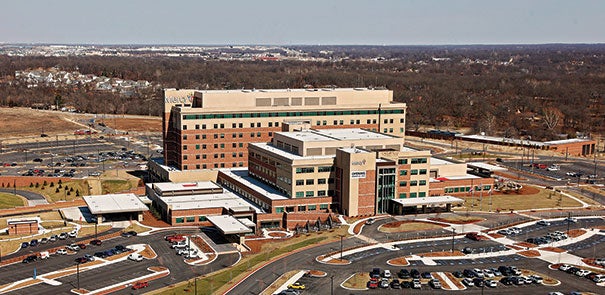New Mercy Hospital Joplin takes resiliency to new level
 |
| PHOTO COURTESY OF MERCY The new Mercy Hospital Joplin is designed and built to withstand severe weather. |
The opening of a new hospital is an important event for any community, but it was an especially momentous occasion when the new Mercy Hospital Joplin (Mo.) opened its door to patients in March.
The new 900,000-sq.-ft., $465 million, state-of-the-art facility represents a crowning piece of the massive recovery effort undertaken by a community ravaged by a tornado in May 2011.
Mercy Hospital Joplin replaces the former St. John’s Regional Medical Center, which was little more than a shell after the EF-5 tornado tore through Joplin. There were 161 fatalities, more than 1,000 injuries and damages totaling an estimated $2.8 billion. Despite the devastation, Joplin has bounced back and the new hospital is a symbol of that rebirth.
“I think the community has recovered very well here,” says John Farnen, Mercy’s executive director for strategic projects, based in Chesterfield, Mo. “This is the last piece of the puzzle that Mercy has been restored — and all is good.”
Built on schedule and under budget, the new hospital takes structural resiliency to a new level, but also features a host of technology and design elements that put patient care at the forefront.
The hospital installed an advanced linear accelerator for cancer treatment, an extensive electronic health record system, an advanced telemedicine system that links the hospital with physicians at other facilities in the Mercy system, a cutting-edge emergency department that maximizes workflow and patient convenience, a neonatal intensive care unit and much more.
The design process and entire project were accelerated by the fact that Cindy Beckham, executive director of facility design at Mercy, headed up the development of design guidelines for the health system about a year and a half before the tornado struck. Prefabrication of elements such as headwalls and bathrooms also contributed to the speed of construction, she adds.
Making the patient experience comfortable and pleasant was a high priority. The experience starts with accessible parking and continues with open spaces and natural daylighting in public areas, not to mention efficient wayfinding, thanks in large part to the facility’s layout, she says.
The 200 private rooms promote quiet comfort and plenty of space for family and staff, Beckham says. The overall design emphasizes use of neutral color and durable, interchangeable materials and finishes to make change easier, Beckham says.
“Our goal with the interior design was to provide flexibility for today and to allow space to be adapted in the future, if necessary,” she says.
As would be expected, the new hospital has been storm-hardened to an apparently unsurpassed level, Farnen says. The design team used the old hospital as a guide to determine which materials withstood damage from the tornado.
Installing storm-proof windows was a priority. Custom-made safety laminated windows that are rated to withstand damage up to 250 mph, 140 mph or 110 mph were installed depending on specific space needs and the vulnerability of occupants in that area, he says. Precast concrete finishes and a concrete roof helped to harden the exterior.
Mechanical equipment was installed in a hurricane-proof penthouse floor at the top of the hospital and in the basement, depending on which floors they serve. Utilities are housed partially underground and inside 12-inch concrete walls covered with brick and connected to the hospital by a tunnel, Farnen says.
Electrical power is backed up by emergency generators housed in the utility plant, which can keep the hospital operating for up to 96 hours. Battery power for hallway and stairwell lights and critical life support systems provides another layer of redundancy.
Even with the rugged exterior, the emergency plan is to move patients into the building’s core area where ceilings and walls strengthened with extra supports provide even more protection from severe weather, he says. Even the storm-hardened doors contribute to safety, one more piece of the design puzzle, helping to ensure that all is well.




